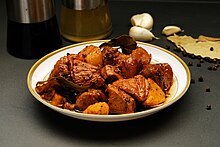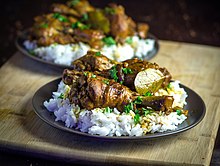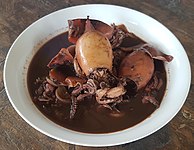Philippine adobo
 A bowl of pork adobo | |
| Course | Main course |
|---|---|
| Place of origin | Philippines |
| Associated cuisine | Filipino cuisine |
| Serving temperature | Hot |
| Main ingredients | Meat (beef, chicken, pork), seafood, or vegetables; soy sauce, vinegar, cooking oil, garlic, black peppercorn, bay leaf |
| Variations | Some sugar for sweet-salty taste. Adobo with no broth, only coating on the chicken. |
| Similar dishes | Paksiw, kinilaw, estofado |
Philippine adobo (from
History
The cooking method for the Philippine adobo is indigenous to the Philippines. The various

There are four main traditional cooking methods using vinegar in the Philippines:
When the
The Spanish also applied the term adobo to any native dish that was marinated before consumption. However, the concept of cooking adobo already existed long before the arrival of the Spanish in 1521.[12]
In the 1794 edition of the Vocabulario, it was applied to quilauìn (
Description

While the adobo dish and cooking process in Filipino cuisine and the general description of

While the Philippine adobo can be considered adobo in the Spanish sense—a marinated dish—the Philippine usage is much more specific to a cooking process (rather than a specific recipe) and is not restricted to meat.[18] Typically, pork or chicken, or a combination of both, is slowly cooked in vinegar, crushed garlic, bay leaves, black peppercorns, and soy sauce. It is served with white rice.[10][21][22] It was traditionally cooked in small clay pots (palayok or kulon); but today, metal pots or woks (kawali) are largely used instead.[23]
There are numerous variants of the adobo recipes in the Philippines.
A rarer version without soy sauce is known as adobong puti ("white adobo"), which uses salt instead, to contrast it with adobong itim ("black adobo"), the more prevalent versions with soy sauce.

Adobong dilaw ("yellow adobo"), which uses kalawag (turmeric) to provide the yellow colouring as well as adding in a different flavour, can be found in Batangas, the Visayas, and Mindanao regions.
The proportion of ingredients like soy sauce, bay leaves, garlic, or black pepper can vary. The amount and thickness of the sauce also varies as some like their adobo dry while some like it saucy. Other ingredients can sometimes be used; like siling labuyo, bird's eye chili, jalapeño pepper, red bell pepper, olive oil, onions, brown sugar, potatoes, pineapple, or lemon-lime sodas like Sprite. It may also be further browned in the oven, pan-fried, deep-fried, or even grilled to get crisped edges.[22][28]
Adobo has been called the quintessential Philippine stew, served with rice both at daily meals and at feasts.[21] It is commonly packed for Filipino mountaineers and travelers because it keeps well without refrigeration. Its relatively long shelf-life is due to one of its primary ingredients, vinegar, which inhibits the growth of bacteria.[10]
Variations

Based on the main ingredients, the most common adobo types are adobong manók, in which chicken is used, and adobong baboy, in which pork is used. Adobong baka (
More exotic versions include adobong sawâ (
There are also regional variations. In
Adobo has also become a favorite of Filipino-based fusion cuisine, with avant-garde cooks coming up with variants such as "Japanese-style" pork adobo.[36]
- Philippine adobo variants
-
Adobong manók (chicken) over rice
-
Adobo sa gatâ (with coconut milk)
-
Adobong baboy (pork) with pineapple
-
Adobong talóng
(eggplant) -
Adobong kamaru
(mole crickets) -
Adobong kangkóng
(water spinach) -
Adobong hipon (shrimp)
-
Adobong pusít (squid)
-
Vegetarianadobo
Other uses
Outside of the dish itself, the flavor of adobo has been developed commercially and adapted to other foods. A number of local Philippine snack products such as cornicks, nuts, chips, noodle soups, and corn crackers, market their items as "adobo flavored".
Standardization
In 2021, the Bureau of Philippine Standards of the Department of Trade and Industry (DTI-BPS) of the Philippines unveiled plans to standardize the most popular Filipino dishes to make it easier to promote them internationally as well as keep their cultural identity. Philippine adobo will be the first of such dishes to be standardized. The definition will be set by a technical committee headed by Glenda Rosales Barreto, and includes representatives from the academia, government departments, the food industry, chefs, and food writers. The main reference will be Kulinarya: A Guidebook to Philippine Cuisine (2008), authored by Barreto and the committee vice-chairperson Myrna Segismundo, both notable chefs of Filipino cuisine in their own right.[37][38] The announcement has received some criticism from the public, but the DTI-BPS clarified that it's not mandatory and will only aim to define a basic traditional recipe that can serve as a benchmark for determining the authenticity of Filipino dishes in the international setting.[39][40]
In popular culture
On March 15, 2023, Google Doodles released a Philippine Adobo doodle.[41]
See also
- Ayam kecap - similarly styled dish from Indonesia and Malaysia
- Semur (Indonesian stew) - similarly styled dish from Indonesia
- Tsukudani - similar cooking technique from Japan
References
- ^ "Calories in Filipino Pork Adobo - Calories and Nutrition Facts - MyFitnessPal.com". www.myfitnesspal.com.)
- ^ "Calories in Beef Adobo and Nutrition Facts". www.fatsecret.com.
- ^ "Calories in Chicken Adobo and Nutrition Facts". www.fatsecret.com.
- ISBN 9781572841130.
- ^ Pangilinan, Leon Jr. (October 3, 2014). "In Focus: 9 Facts You May Not Know About Philippine National Symbols". National Commission for Culture and the Arts. Retrieved January 8, 2019.
- ^ ISBN 9781903018477.
- ^ ISBN 9781579658823.
- ^ a b c Dacanay, Barbara Mae Naredo (May 1, 2019). "There's nothing Spanish about adobo—should we ditch its Spanish name?". ANC X. Retrieved March 10, 2021.
- ^ "ADOBO: A History of the Country's National Dish". July 14, 2008.
- ^ ISBN 9780313304156.
- ^ a b c Estrella, Serna (June 22, 2013). "Adobo: The History of A National Favorite". Pepper.ph. Retrieved March 21, 2016.
- ^ "What Is Adobo? The Answer Is as Complex as the Dish Itself". Food & Wine. Retrieved May 25, 2023.
- ^ Domingo de los Santos (1794). Vocabulario de la lengua tagala, primera y segunda parte: en la primera, se pone primero el Castellano, y despues el Tagalo : y en la segunda al contrario, que son las rayzes simples con sus accentos (in Spanish). N.S. de Loreto. p. 42.
Adobo. Quilauìn. (pc) toman sàl vinagre, y chíle, y lo echan en la carne, pescado, ò tripas de venado; y asi medio crudo lo comen . . . Este mismo genero de adobo sirve para las yervas como ensalada.
- JSTOR 29792029.
- ^ R. P. Matheo Sanchez (1711). Vocabulario de la lengua Bisaya. Colegio de la Sagrada Compania de Jesus. p. 198.
Gamus. up. f Gamusun vel. gamsun. Salar o adobar carne, o pescado; ba cun gagamsun an isda sagan sin saguing, sin chile, sua. &c
- ^ a b Ocampo, Ambeth. (February 24, 2009). "Looking Back: 'Adobo' in many forms". Philippine Daily Inquirer. Archived from the original on May 23, 2015. Retrieved August 4, 2010.
- ISBN 9781440508486.
Philippine Adobo variation.
- ^ a b c d e f Claude Tayag (March 8, 2012). "The adobo identity (crisis)". The Philippine Star. Retrieved November 7, 2012.
- ^ Zulu, Mijon (November 19, 2017). "What Is the Difference Between Mexican and Filipino Adobo?". Chowhound. Retrieved January 9, 2019.
- ^ "This Chicken Adobo Is a Flavor Bomb of Salty-Sour Goodness". CookingLight. Retrieved January 10, 2019.
- ^ ISBN 0-19-280681-5.
- ^ a b c d Sifton, Sam (January 5, 2011). "The Cheat: The Adobo Experiment". The New York Times.
- ^ ISBN 9780495115410.
- ^ Artie Sy (August 11, 2011). "The Admirable Adobo". Sun Star. Archived from the original on August 14, 2011. Retrieved November 7, 2012.
- ^ "Adobong Puti (White Chicken Adobo) for Kulinarya Cooking Club". FoodPress. June 19, 2011. Retrieved November 7, 2012.
- ^ "The BEST Pork Adobo a la Marketman". Market Manila. May 7, 2008. Retrieved November 7, 2012.
- ^ "Adobong Puti (White Adobo)". AdobongBlog. October 4, 2011. Retrieved November 7, 2012.
- ^ Cordero-Fernando, Gilda (1976). The Culinary culture of the Philippines. Bancom Audiovision Corp. pp. 11–13.
- ^ Jeroen Hellingman (March 28, 2003). "Adobong Baka (Beef)". Bohol.ph. Retrieved November 7, 2012.
- ISBN 9780399511448.
- ^ "Traditional Adobo Recipes". AdoboChef. January 5, 2011. Archived from the original on June 18, 2012. Retrieved June 22, 2012.
{{cite web}}: CS1 maint: unfit URL (link) - ^ "Only for the Daring: Exotic Food Finds in Cebu". Cebutourist. June 17, 2011. Archived from the original on January 19, 2013. Retrieved November 7, 2012.
- ^ "Adobong Palaka". San Pablo City. October 14, 2010. Archived from the original on April 16, 2013. Retrieved November 7, 2012.
- ^ "Adobong Atay at Balunbalunan (Chicken Liver and Gizzard)". Reel and Grill. December 9, 2010.
- ^ Javellana, Abigail (April 24, 2017). "IVATAN CUISINE: The Flavors of the Batanes Isles! • Awesome!". Awesome!. Retrieved December 9, 2020.
- ^ Manipon, Roel Hoang (February 1, 2016). "Japanese-style adobo and other delicious things you can cook in a microwave oven". The Daily Tribune. Archived from the original on February 1, 2016. Retrieved March 23, 2018.
- ^ "Standardization of famous Filipino dishes advances!". Department of Trade and Industry. July 9, 2021.
- ^ Canivel, Roy Stephen C. (July 10, 2021). "Committee to decide what is 'standard' adobo". Philippine Daily Inquirer.
- ^ Ramos, Christia Marie (July 12, 2021). "DTI says standardizing Philippine adobo only for international promotion". Philippine Daily Inquirer. Retrieved July 13, 2021.
- ^ Punzalan, Jamaine (July 12, 2021). "Standard adobo, sinigang, sisig? DTI says aiming for international promotion". ABS-CBN News. Retrieved July 13, 2021.
- ^ Celebrating Filipino Adobo, retrieved March 15, 2023
External links
 Media related to Adobo (Filipino cuisine) at Wikimedia Commons
Media related to Adobo (Filipino cuisine) at Wikimedia Commons Adobo at the Wikibooks Cookbook subproject
Adobo at the Wikibooks Cookbook subproject












